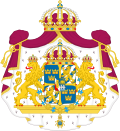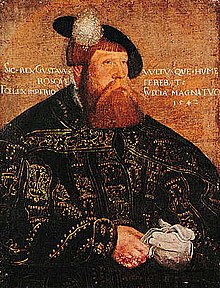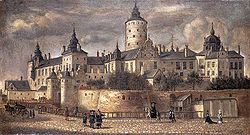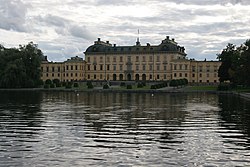Monarchy of Sweden: Difference between revisions
links |
|||
| Line 127: | Line 127: | ||
{{main|Swedish Royal Family}} |
{{main|Swedish Royal Family}} |
||
The Swedish Royal Family consists of two groups; firstly, those with royal [[title]]s and style (manner of address) who perform official and unofficial engagements for the nation, are the members of the Royal House ({{lang-sv| |
The Swedish Royal Family consists of two groups; firstly, those with royal [[title]]s and style (manner of address) who perform official and unofficial engagements for the nation, are the members of the Royal House ({{lang-sv|Kungl. Huset}}); and secondly, the extended family of the King ({{lang-sv|kungliga familjen}}) which is other close relatives who are not dynasts and thus do not represent the country officially. However, there is no legislation or other formal instrument of the government which delineates the extent of membership in the Royal Family, as it is left to the sole disrection of the King. |
||
=== The line of succession === |
=== The line of succession === |
||
Revision as of 22:02, 28 February 2014
| King of Sweden | |
|---|---|
| Sveriges Konung | |
 | |
| Incumbent | |
 | |
| Carl XVI Gustaf since 15 September 1973 | |
| Details | |
| Style | His Majesty |
| First monarch | Eric the Victorious (first monarch of undisputed historicity) |
| Formation | Unknown |
| Residence | Stockholm Palace[1] Drottningholm Palace[2] |
| Website | The Royal Court of Sweden |
| History of Sweden |
|---|
 |
| Timeline |
|
|
The Monarchy of Sweden concerns the monarchical head of state of Sweden,[3] which is a constitutional and hereditary monarchy with a parliamentary system.[4] The Kingdom of Sweden (Swedish: Konungariket Sverige) has been a monarchy since time immemorial. Originally an elective monarchy, it became an hereditary monarchy only in the 16th century during the reign of Gustav Vasa.[5]
Sweden in the present-day is a representative democracy in a parliamentary system based on popular sovereignty, as defined in the current Instrument of Government (one of the four Fundamental Laws of the Realm which makes up the written constitution[6]). The role of the Monarch is to be a strictly ceremonial head of state, and has no part in the formal governance of the Realm.[7][8] The Monarch and the members of Royal Family undertake a variety of official, unofficial and other representational duties within Sweden and abroad.[5]
The current monarch, Carl XVI Gustaf, has reigned since 15 September 1973, when he became King upon the death of his grandfather, Gustaf VI Adolf.[9]
History


Sweden has been a kingdom since prehistoric times. As early as the 1st century, Tacitus wrote that the Suiones had a king, but the order of succession to the later historic kings of Sweden, before King Eric the Victorious (died 995), is only known by what is accounted for in the historically controversial Norse sagas (see Mythical kings of Sweden and Semi-legendary kings of Sweden).
Originally, the Swedish king had power limited to the functions of a warchief, judge and priest at the Temple at Uppsala (see Germanic king). It is a testimony to lack of influence[according to whom?] that there are thousands of runestones commemorating commoners, but no chronicle about the Swedish kings, prior to the 14th century (though a list of kings was added in the Westrogothic law), and only a few runestones that may mention kings: Gs 11 (Emund the Old), U 11 (Haakon the Red) and U 861 (Blot-Sweyn).
The power of the king was greatly strengthened by the introduction of Christianity during the 11th century, and the following centuries saw a process of consolidation of power in the hands of the king. The king was traditionally elected from a favored dynasty at the Stones of Mora, and the people had the right to both elect the king and to depose him. The stones were, however, destroyed around 1515.
Legally, however, Sweden has only been a hereditary monarchy since 1544 when the Riksdag of the Estates, through Västerås arvförening, designated the heirs of King Gustav Vasa as the heirs to the Throne.
The powers of the king were originally regulated by a partition of the written legal code called Konungabalk (English: Kings' partition) from medieval times until 1734, when a new law code of Sweden was adopted and this partition of the law was removed. This new law code of Sweden was adopted after a long period of inquiries by royal commissions since the days Charles IX (late 16th/early 17th century) on a new legal code to replace the medieval one.
The 1634 Instrument of Government and altering hereditary rules also regulated the monarchy until 1719, when a fully written constitution, the 1719 Instrument of Government, came into force. This constitution was replaced one year later by the 1720 Instrument of Government, which limited the powers of the monarch even more than the 1719 statute did. The 1720 statute was later replaced by the 1772 Instrument of Government.
As a result of the poorly managed Finnish war, on 17 September 1809, in the Treaty of Fredrikshamn, Sweden had to surrender the eastern half of Sweden to Russia. King Gustav IV Adolf and his descendants were deposed in a coup d'etat led by dissatisfied army officers. The childless uncle of the former king was later elected as Charles XIII. The Instrument of Government of 1809 put an end to notions of royal absolutism by dividing the legislative power between the Riksdag (primary) and the King (secondary), and vested executive power in the King when acting through the Council of State.
The present Bernadotte dynasty was established in September 1810 when the Riksdag, convened in Örebro, elected French Marshal and Prince of Ponte Corvo Jean Baptiste Jules Bernadotte as heir designate. The reason for this procedure was that there were no heirs of Charles XIII and the previously elected heir in January 1810, Charles August, had suddenly died in a stroke.
Following the de facto breakthrough of parliamentarism in 1917 the King's powers were in practice considerably reduced, and he became a figurehead with only limited political authority. In 1975, with the adoption of a new Instrument of Government, the monarch was de jure reduced to a mere figurehead without any formal political powers left.
Head of state duties (post 1974)
 |
|---|
In 1975 the Instrument of Government of 1974 (Swedish: 1974 års regeringsform), replacing the Instrument of Government of 1809, became part of the Fundamental Laws of the Realm. It transformed the (technically) advisory Council of State (Swedish: Statsrådet) into the collegial Government (Swedish: Regeringen) in which all executive power was vested, and thus the Monarch was stripped of all executive powers, while still retained as purely ceremonial figurehead with residual executive authority over only his own court and household. Responsibility for appointing and dismissing the Prime Minister was transferred to the Speaker of the Riksdag. The Prime Minister appoints and dismisses his ministers at his or her sole discretion. Bills passed in the Riksdag become law without having to acquire royal assent: the Prime Minister or another cabinet minister signs it "On Behalf of the Government" (Swedish: På regeringens vägnar). Thus, in Sweden, unlike most constitutional monarchies, the Monarch is no longer even the nominal chief executive.[7]
The Monarch formally, at the request of the Speaker, opens the annual session of the Riksdag and chairs a special Cabinet Council in a session that establishes the new government following a general election or major cabinet reshuffle. He also chairs this Council approximately four times a year to get information from the Cabinet apart from that given by the Prime Minister. The Monarch also chairs the Advisory Committee for Foreign Affairs (Swedish: Utrikesnämnden), a body which serves to officially inform the head of state and the leaders of the opposition on foreign affairs.[8]
Titles


Monarch
A simplified title that was sometimes used in less formal circumstances was Rex Sveciae or Sveriges Konung, the king of Sweden. The traditional full title of the Swedish monarch was:
- Swedish: Med Guds Nåde Sveriges, Götes och Vendes Konung ("By the Grace of God, King of the Swedes, the Goths/Geats and the Wends")
- Latin: Dei Gratia Suecorum, Gothorum et Vandalorum Rex - sometimes the first part of the Latin title was Svionum or Sveonum, all three words meaning of the Swedes, not Sweden.
Before 1818, the King of Sweden had many more titles since the times of Sweden as a great power. As the first king of the House of Bernadotte, Charles XIV John, acceded the throne in 1818, these extra titles (except the title above) were dropped. The Instrument of Government of 1809 was also written in a more analytic and contemporary Swedish language, better defined by the Swedish Academy established 21 years earlier. The titles removed from the style in 1818 were:
- Grand Prince of Finland, Duke of Scania, Estonia, Livonia, Karelia, Bremen, Verden, Stettin, Pomerania, Kashubia and Wendia, Prince of Rügen, Lord of Ingria and Wismar, Count Palatine of the Rhine, Duke of Bavaria, Jülich, Cleves and Berg.
During the reign of the Holstein-Gottorp dynasty (1751-1818) the title heir to Norway (Swedish: Arvinge till Norge) was added,[10] as also other titles that were connected to the dukes of Holstein-Gottorp. When Norway after the Napoleonic wars was included in a personal union with Sweden, the title King of Norway also was included in the title. In older spelling in Swedish the title was Sweriges, Norriges, Göthes och Wendes Konung.
The traditional full title first mentioned here had been in use since the establishment of the hereditary monarchy in 1544. For example the title Vendes Konung "King of the Wends" started to be used then. However the title Götes Konung "King of the Goths", dates back to at least the kings Magnus Ladulås, Erik the Saint and Charles Sverkersson (maybe also Inge the Elder in a letter from the Pope). The title King of the Swedes Svea Konung, dates back to those times as well and even further back. This latter title was however already in the 16th century changed to the title Sveriges Konung, King of Sweden, and this short form of the title was also used frequently.
Carl XVI Gustaf instead at his accession chose the plain and simple title King of Sweden (Swedish: Sveriges Konung).[9] Such innovations are reflected in his personal motto För Sverige, i tiden ("For Sweden, with the times") and also contemporarily in neighbouring countries: Queen Margrethe II of Denmark did the same in 1972, while Harald V of Norway bears no extra titles except "King of Norway".
Heirs to the throne
The title of the heir apparent is Crown Prince of Sweden (Swedish: Sveriges Kronprins) or if female Crown Princess of Sweden (Swedish: Sveriges Kronprinsessa), and the wife of a crown prince would also receive the title of crown princess but not the other way around. The traditional official title, used until 1980, for other dynastic male heirs was Hereditary Prince of Sweden (Swedish: Sveriges arvfurste), although the word prince (Swedish: prins) was used in constitutional legal texts such as the Instrument of Government of 1809 and also colloquially and informally. The title of princesses was in all cases Princess of Sweden (Swedish: Prinsessa av Sverige). Beginning in 1980, the official title of all dynasts is "Prince/Princess of Sweden" (Swedish: Prins/Prinsessa av Sverige).
Ducal titles
King Gustav III revived a tradition from the days of Gustav Vasa and also from medieval times by giving the dynastic male heirs to the throne ducal titles of Swedish provinces. The key difference between the ducal titles from the Vasa era and those handed out from Gustav III up until the present day is that they now are merely non-hereditary courtesy titles given at birth with no feudal rights attached. From 1980 they are conferred to all dynastic heirs, male as well as female. The wives share the title, as do husbands since a new precedent established in 2010.
Symbols of the Monarchy
Regalia

Sweden's Royal Regalia are kept deep in the vaults of the Treasury chamber (Swedish: Skattkammaren), located underneath the Royal Palace in Stockholm, in a museum which has been open to the public since 1970. The Regalia is State property. Among the oldest objects in the collection are the sword of Gustav Vasa and the crown, orb, sceptre and key of King Erik XIV. The crowns and coronets have not been worn by Swedish royals since 1907, but they are still displayed at weddings, christenings and funerals. Until 1974 the crown and sceptre were also displayed on cushions at the solemn opening of the Riksdag.[12][13][11]
Royal residences
The Royal Palace

The Royal Palace ([Kungliga slottet] Error: {{Lang}}: text has italic markup (help)), also known as Stockholm Palace (Swedish: Stockholms slott), is the official residence of the King. The Royal Palace is located on Stadsholmen ("city island"), commonly known as Gamla Stan ("the old town") in the national capital city Stockholm.
The offices of the King, the other members of the Swedish Royal Family, and the offices of the Royal Court are located in the Palace. The Royal Palace is used for representative purposes and State occasions by the King.[1] The Royal Palace is guarded by Högvakten, a royal guard, consisting of regular servicemembers of the Swedish Armed Forces. The tradition of a maintaining a royal guard at the royal residence dates back to 1523. Until the mid 19th century, The royal guards who also maintained law and order in the city and provided fire-fighting services.[14]
The southern façade is facing the grand-style slope Slottsbacken; the eastern façade is bordering Skeppsbron, an impressive quay passing along the eastern waterfront of the old town; on the northern front is Lejonbacken, a system of ramps named after the Medici lions sculptures on the stone railings; and the western wings border the open space Högvaktsterrassen. The Royal Palace in Stockholm is unique among European royal residences in that large portions of it are open year round to visitors.[1]

The first building on this site was a fortress with a core tower built in the 13th century by Birger Jarl to defend the entry into Lake Mälaren. The fortress gradually grew to a castle, known as Tre Kronor: named after the spire on the centre tower with the Three Crowns, which has become the Swedish national symbol.
In the late 16th century, much work was done to transform the castle into a Renaissance-style palace during the reign of John III. In 1690, it was decided to rebuild the palace in Baroque style after a design by Nicodemus Tessin the Younger. In 1692, work began on the northern row. It was complete in 1697, but much of the castle was destroyed in a disastrous fire on 7 May 1697.
Tessin rebuilt the damaged palace, and work continued for another 63 years. Half-round wings around the outer western courtyard were finished in 1734, the palace church was finished in the 1740s, and the exterior was finished in 1754. The royal family moved to the palace with the southwest, southeast, and northeast wings finished. The northwest wing was finished in 1760. In the north, the Lejonbacken ("Lion's Slope") was rebuilt from 1824 to 1830. Its name comes from the Medici lions-inspired sculptures that stand there.
Drottningholm Palace

Drottningholm Palace (Swedish: Drottningholms slott) is located at Drottningholm on the island Lovön (in Ekerö Municipality of Stockholm County), and is one of Sweden's Royal Palaces. It was originally built in the late 16th century. It has served as a residence of the Swedish royal family members for most of the 18th and 19th centuries. Apart from being the is the current home residence of Their Majesties the King and Queen, Drottningholm Palace is a popular tourist attraction.[2]
The gardens and park areas surrounding Drottningholm Palace and adjacent its buildings are one of the main attractions for the tourists that visit the palace each year. The gardens have been established in stages since the palace was first built, resulting in many different styles of parks and gardens.[15]
The Royal Domain of Drottningholm is a well-preserved milieu from the 17th and 18th centuries, inspired by French models such as the Chateau of Versailles is a UNESCO World Heritage Site, principally because of the Drottningholm Palace Theatre and the Chinese Pavilion at Drottningholm. It was added to the World Heritage List in 1991.[16]
Haga Palace

Haga Palace (Swedish: Haga slott), formerly known as the Queen's Pavilion (Swedish: Drottningens paviljong), is located in the Haga Park, Solna Municipality in Metropolitan Stockholm. The palace, built in between 1802 – 1805, was modelled after ballet-master Gallodiers Italian villa at Drottningholm by architect Carl Christoffer Gjörwell on appointment by King Gustaf IV Adolf for the royal children. It has been the home or summerhouse for several members of the Swedish royal family – most notably it was the birthplace of the present King Carl XVI Gustaf – until 1966 when King Gustaf VI Adolf transferred its disposal to the Prime Minister and it was turned into a guesthouse for distinguished foreign official visitors (heads of state and heads of government etcetera).[17]
In 2009, it was announced by Prime Minister Fredrik Reinfeldt that the rights of disposal to the palace will be transferred back to the royal court to be used by Victoria, Crown Princess of Sweden, and her husband, Prince Daniel, Duke of Västergötland, as a wedding gift in 2010. They moved into Haga Palace after their wedding on 19 June 2010.
Royal Family
 |
|
The Swedish Royal Family consists of two groups; firstly, those with royal titles and style (manner of address) who perform official and unofficial engagements for the nation, are the members of the Royal House (Swedish: Kungl. Huset); and secondly, the extended family of the King (Swedish: kungliga familjen) which is other close relatives who are not dynasts and thus do not represent the country officially. However, there is no legislation or other formal instrument of the government which delineates the extent of membership in the Royal Family, as it is left to the sole disrection of the King.
The line of succession
The Act of Succession of 1810 designates the legitimate heirs of Charles XIV John (House of Bernadotte) as the heirs to the Swedish Throne; it also states in article 4 that the Monarch and dynastic members of the Royal House must be a Protestant Christian of the pure evangelical faith (by implication the Church of Sweden).
A rewrite of the Act, entering into force in 1980, fundamentally changed the rules of succession from agnatic primogeniture to absolute primogeniture. This allowed for the crown to pass to the eldest child regardless of gender and thus retroactively installed Princess Victoria as Crown Princess (heir apparent) over her younger brother Prince Carl Philip who had been born as Crown Prince.
In its present reading, Article 1 in the Act of Succession limits the line of succession to the throne so that only descendants of Carl XVI Gustaf may inherit the Throne.[18]
See also
References

- Template:Translation/Ref
- The Instrument of Government (PDF). Stockholm: The Riksdag. 2012 (translation date).
{{cite book}}: Check date values in:|date=(help) - The Act of Succession (PDF). Stockholm: The Riksdag. 2012 (translation date).
{{cite book}}: Check date values in:|date=(help) - The Riksdag Act (PDF). Stockholm: The Riksdag. 2012 (translation date).
{{cite book}}: Check date values in:|date=(help)
Notes
- ^ a b c "The Royal Palace of Stockholm". Royal Court of Sweden. Retrieved 2014-02-23.
- ^ a b c "Drottningholm Palace". Royal Court of Sweden. Retrieved 2014-02-23.
- ^ See the Instrument of Government, Chapter 1, Article 5.
- ^ Parliamentary system: see the Instrument of Government, Chapter 1, Article 1.
- ^ a b "The Monarchy in Sweden". Royal Court of Sweden. Retrieved 2014-02-22.
- ^ "The Constitution". The Riksdag. Retrieved 2014-02-22.
- ^ a b "The Head of State". Government of Sweden. Retrieved 2014-02-22.
- ^ a b "Duties of the Monarch". Royal Court of Sweden. Retrieved 2014-02-22.
- ^ a b Template:Sv icon SFS (1973:702)
- ^ See the preamble to the Act of Succession.
- ^ a b "History, The Treasury". Royal Court of Sweden. Retrieved 2014-02-23.
- ^ "Regal symbols". Royal Court of Sweden. Retrieved 2014-02-23.
- ^ "The Treasury". Royal Court of Sweden. Retrieved 2014-02-23.
- ^ "About the Royal Guards". Swedish Armed Forces. Retrieved 2014-02-26.
- ^ "Drottningholm Palace Park". Royal Court of Sweden. Retrieved 2014-02-26.
- ^ "The World Heritage". Royal Court of Sweden. Retrieved 2014-02-26.
- ^ "Buildings in Haga Park". Royal Court of Sweden. Retrieved 2014-02-26.
- ^ See Act of Succession, Article 1.
External links
- The Royal Court of Sweden - Official website
- Kungahuset on Vimeo - Official video channel on Vimeo
- Livrustkammaren - The Royal Armoury
- The Swedish Republican Association (Republikanska föreningen)
- Rojalistiska föreningen Template:Sv icon
